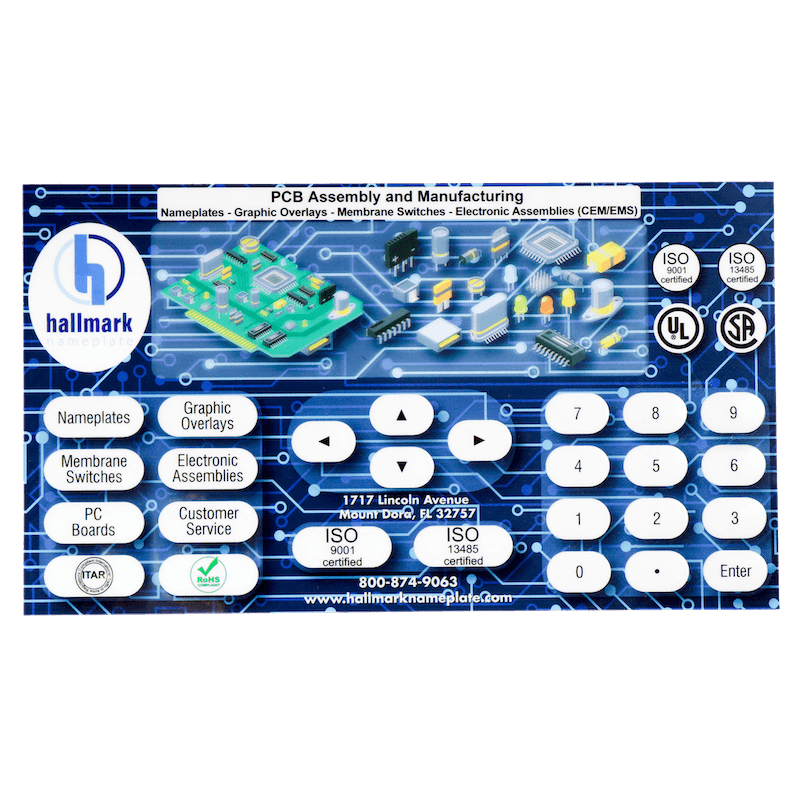Why Membrane Switches are Ideal for Durability and Performance
Why Membrane Switches are Ideal for Durability and Performance
Blog Article
Comprehending Membrane Layer Switches Over: The Trick to Long Lasting and Trusted Controls

What Are Membrane Buttons?
Membrane switches are a sophisticated remedy in the world of user interface technology, combining performance and layout seamlessly. These gadgets work as an interface between individuals and digital systems, incorporating a number of parts right into a portable layout. Usually created from adaptable, thin layers of materials, membrane buttons are developed to react to touch, allowing individuals to communicate with machinery and electronic gadgets successfully.
The key aspects of a membrane button include a published circuit layer, graphic overlay, and a spacer layer that protects against unexpected activation. The graphic overlay can be tailored to reflect brand name identity or user preferences, boosting appearances while ensuring functionality. Membrane layer buttons are commonly used in numerous applications, including medical gadgets, consumer electronics, and commercial equipment, owing to their sturdiness and resistance to ecological factors such as dampness and dust.
Among the vital advantages of membrane layer buttons is their ability to withstand damage, making them excellent for high-traffic atmospheres. In addition, they are light-weight and require very little space, enabling ingenious layouts in item development. In general, membrane layer switches over represent a functional and efficient selection for contemporary electronic interfaces, marrying modern technology with user-centric layout concepts.
Exactly How Membrane Switches Over Work
The procedure of membrane layer switches joints on a straightforward yet effective system that equates customer input right into electronic signals. When an individual presses the button, the top layer deforms, allowing a conductive element in the circuit layer to make contact with a matching conductive pad on the bottom of the graphic overlay.
The style of membrane buttons can differ, but they usually incorporate domes or responsive elements to give responses to the user, improving the overall experience - membrane switch. The materials used in membrane layer buttons, such as polyester or polycarbonate, contribute to their resilience and resistance to ecological variables, consisting of moisture and dust. The published circuits are commonly enveloped, which shields them from wear and tear over time.
Advantages of Membrane Layer Switches

In addition, membrane layer switches are understood useful reference for their toughness. Created from durable products, they are immune to dirt, dampness, and physical wear, which significantly extends their lifespan compared to conventional mechanical switches. This resilience makes them especially appropriate for high-traffic atmospheres and applications needing durability.
One more significant benefit is the ease of cleansing and upkeep. The smooth surface area of membrane layer changes reduces dust accumulation and is frequently unsusceptible spills, making them perfect for settings that require constant sanitization.
In addition, membrane layer switches provide a streamlined account, causing a thinner style that can be integrated into numerous gadgets without adding bulk. This feature not just enhances the visual charm however likewise adds to a much more ergonomic product design.
Applications of Membrane Switches
Easy to use and versatile, membrane layer buttons discover applications throughout a wide variety of markets, including clinical tools, consumer electronic devices, and commercial equipment. In the medical area, these switches are important to tools such as diagnostic devices, individual monitoring systems, and mixture pumps, where dependability and ease of cleansing are crucial. Their capacity to stand up to harsh settings and maintain capability makes them optimal for such applications.

In customer electronic devices, membrane buttons are made use of in products like microwaves, cleaning equipments, and remote controls - membrane switch. Their streamlined design enables instinctive interface, enhancing the general customer experience while providing toughness and resistance to tear and wear
Industrial tools additionally gains from membrane switches, especially in control panels for equipment and automation systems. These buttons offer security against dust and wetness, making certain consistent go now performance in difficult atmospheres. In addition, their customizable functions enable makers to customize them to details functional demands, enhancing efficiency and functionality.
Choosing the Right Membrane Switch Over
When choosing a membrane switch, it is vital to take into consideration different elements that influence performance and suitability for certain applications. The main factors to consider consist of environmental conditions, tactile comments, longevity, and style requirements.
First, examine the operating environment; switches subjected to moisture, chemicals, or severe temperature levels require particular products to make certain longevity and functionality. Next off, review the demand for tactile responses. Relying on individual communication, some applications might take advantage of a responsive action to verify activation, while others might favor a non-tactile layout for aesthetic factors.
Toughness is one more critical factor; membrane layer buttons ought to be designed to hold up against regular usage, influences, and abrasion. Guarantee the selected button can endure the anticipated lifecycle, especially in high-usage circumstances.

Final Thought
In visit the website conclusion, membrane layer switches over serve as crucial elements in the layout of reputable and sturdy control systems across various markets. The versatility of membrane switches over enables for customized solutions that fulfill certain operational needs, reinforcing their relevance in modern-day technology.
Membrane layer switches represent a crucial facet of modern interface layout, mixing functionality with durability in various applications.Membrane buttons are a sophisticated solution in the world of individual interface modern technology, combining functionality and style seamlessly. Generally created from flexible, slim layers of materials, membrane layer switches are designed to react to touch, making it possible for users to communicate with machinery and electronic tools effectively.
The style of membrane layer buttons can vary, however they commonly incorporate domes or tactile elements to supply feedback to the user, boosting the total experience.In verdict, membrane changes offer as important parts in the layout of sturdy and trustworthy control systems throughout numerous sectors.
Report this page